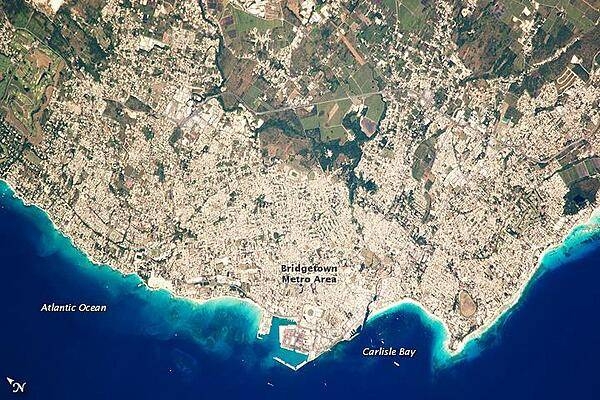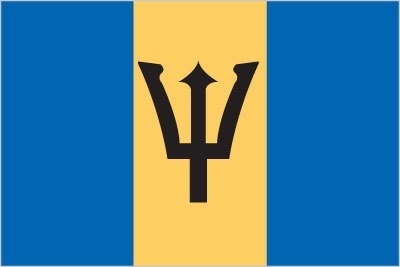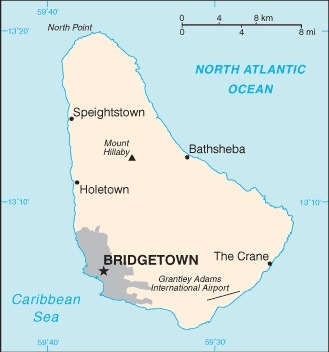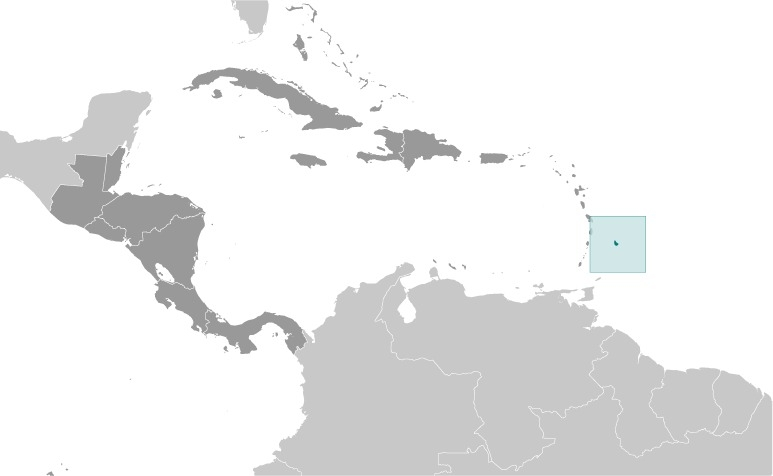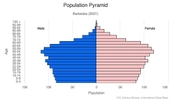Introduction
Background
The island was uninhabited when first settled by the British in 1627. African slaves worked the sugar plantations established on the island, which initially dominated the Caribbean sugar industry. By 1720 Barbados was no longer a dominant force within the sugar industry, having been surpassed by the Leeward Islands and Jamaica. Slavery was abolished in 1834. The Barbadian economy remained heavily dependent on sugar, rum, and molasses production through most of the 20th century. The gradual introduction of social and political reforms in the 1940s and 1950s led to complete independence from the UK in 1966. In the 1990s, tourism and manufacturing surpassed the sugar industry in economic importance. Barbados became a republic on 30 November 2021, with the former Governor-General Sandra MASON elected as the first president.
Visit the Definitions and Notes page to view a description of each topic.
Geography
Location
Caribbean, island in the North Atlantic Ocean, northeast of Venezuela
Geographic coordinates
13 10 N, 59 32 W
Map references
Central America and the Caribbean
Area - comparative
2.5 times the size of Washington, DC
Land boundaries
total: 0 km
Coastline
97 km
Maritime claims
territorial sea: 12 nm
exclusive economic zone: 200 nm
Climate
tropical; rainy season (June to October)
Terrain
relatively flat; rises gently to central highland region
Elevation
highest point: Mount Hillaby 336 m
lowest point: Atlantic Ocean 0 m
Natural resources
petroleum, fish, natural gas
Land use
agricultural land: 32.6% (2018 est.)
arable land: 25.6% (2018 est.)
permanent crops: 2.3% (2018 est.)
permanent pasture: 4.7% (2018 est.)
forest: 19.4% (2018 est.)
other: 48% (2018 est.)
Irrigated land
50 sq km (2012)
Population distribution
most densely populated country in the eastern Caribbean; approximately one-third live in urban areas
Natural hazards
infrequent hurricanes; periodic landslides
Geography - note
easternmost Caribbean island
People and Society
Nationality
noun: Barbadian(s) or Bajan (colloquial)
adjective: Barbadian or Bajan (colloquial)
Ethnic groups
African descent 92.4%, mixed 3.1%, White 2.7%, East Indian 1.3%, other 0.2%, unspecified 0.3% (2010 est.)
Languages
English (official), Bajan (English-based creole language, widely spoken in informal settings)
Religions
Protestant 66.4% (includes Anglican 23.9%, other Pentecostal 19.5%, Adventist 5.9%, Methodist 4.2%, Wesleyan 3.4%, Nazarene 3.2%, Church of God 2.4%, Baptist 1.8%, Moravian 1.2%, other Protestant 0.9%), Roman Catholic 3.8%, other Christian 5.4% (includes Jehovah's Witness 2.0%, other 3.4%), Rastafarian 1%, other 1.5%, none 20.6%, unspecified 1.2% (2010 est.)
Age structure
0-14 years: 17.49% (male 25,762/female 25,764)
15-24 years: 12.34% (male 18,024/female 18,330)
25-54 years: 42.69% (male 62,655/female 63,093)
55-64 years: 13.91% (male 19,533/female 21,430)
65 years and over: 13.57% (male 16,398/female 23,571) (2020 est.)
Dependency ratios
total dependency ratio: 50.3
youth dependency ratio: 25.2
elderly dependency ratio: 25.1
potential support ratio: 4 (2020 est.)
Median age
total: 39.5 years
male: 38.4 years
female: 40.7 years (2020 est.)
Population distribution
most densely populated country in the eastern Caribbean; approximately one-third live in urban areas
Urbanization
urban population: 31.2% of total population (2021)
rate of urbanization: 0.46% annual rate of change (2020-25 est.)
Major urban areas - population
89,000 BRIDGETOWN (capital) (2018)
Sex ratio
at birth: 1.01 male(s)/female
0-14 years: 1 male(s)/female
15-24 years: 0.98 male(s)/female
25-54 years: 0.99 male(s)/female
55-64 years: 0.91 male(s)/female
65 years and over: 0.7 male(s)/female
total population: 0.94 male(s)/female (2020 est.)
Maternal mortality ratio
27 deaths/100,000 live births (2017 est.)
country comparison to the world: 115Infant mortality rate
total: 10.23 deaths/1,000 live births
male: 11.84 deaths/1,000 live births
female: 8.6 deaths/1,000 live births (2021 est.)
Life expectancy at birth
total population: 78.31 years
male: 75.54 years
female: 81.13 years (2021 est.)
Contraceptive prevalence rate
59.2% (2012)
Drinking water source
improved: total: 98.5% of population
unimproved: total: 1.5% of population (2017 est.)
Current Health Expenditure
6.6% (2018)
Physicians density
2.48 physicians/1,000 population (2017)
Hospital bed density
6 beds/1,000 population (2017)
Sanitation facility access
improved: total: 99.2% of population
unimproved: total: 0.8% of population (2017 est.)
HIV/AIDS - deaths
<100 (2019 est.)
Literacy
definition: age 15 and over can read and write
total population: 99.6%
male: 99.6%
female: 99.6% (2014)
School life expectancy (primary to tertiary education)
total: 15 years
male: 14 years
female: 17 years (2011)
Unemployment, youth ages 15-24
total: 26%
male: 30.3%
female: 21.2% (2019 est.)
Environment
Environment - current issues
pollution of coastal waters from waste disposal by ships; soil erosion; illegal solid waste disposal threatens contamination of aquifers
Environment - international agreements
party to: Biodiversity, Climate Change, Climate Change-Kyoto Protocol, Climate Change-Paris Agreement, Comprehensive Nuclear Test Ban, Desertification, Endangered Species, Hazardous Wastes, Law of the Sea, Marine Dumping-London Convention, Marine Dumping-London Protocol, Ozone Layer Protection, Ship Pollution, Wetlands
signed, but not ratified: none of the selected agreements
Air pollutants
particulate matter emissions: 22.24 micrograms per cubic meter (2016 est.)
carbon dioxide emissions: 1.28 megatons (2016 est.)
methane emissions: 2.35 megatons (2020 est.)
Climate
tropical; rainy season (June to October)
Land use
agricultural land: 32.6% (2018 est.)
arable land: 25.6% (2018 est.)
permanent crops: 2.3% (2018 est.)
permanent pasture: 4.7% (2018 est.)
forest: 19.4% (2018 est.)
other: 48% (2018 est.)
Urbanization
urban population: 31.2% of total population (2021)
rate of urbanization: 0.46% annual rate of change (2020-25 est.)
Revenue from forest resources
forest revenues: 0.01% of GDP (2018 est.)
country comparison to the world: 147Waste and recycling
municipal solid waste generated annually: 174,815 tons (2011 est.)
municipal solid waste recycled annually: 15,733 tons (2015 est.)
percent of municipal solid waste recycled: 9% (2015 est.)
Total water withdrawal
municipal: 20 million cubic meters (2017 est.)
industrial: 6.2 million cubic meters (2017 est.)
agricultural: 54.8 million cubic meters (2017 est.)
Total renewable water resources
80 million cubic meters (2017 est.)
Government
Country name
conventional long form: none
conventional short form: Barbados
etymology: the name derives from the Portuguese "as barbadas," which means "the bearded ones" and can refer either to the long, hanging roots of the island's bearded fig trees or to the alleged beards of the native Carib inhabitants
Government type
parliamentary republic; a Commonwealth realm
Capital
name: Bridgetown
geographic coordinates: 13 06 N, 59 37 W
time difference: UTC-4 (1 hour ahead of Washington, DC, during Standard Time)
etymology: named after a bridge constructed over the swampy area (known as the Careenage) around the Constitution River that flows through the center of Bridgetown
Administrative divisions
11 parishes and 1 city*; Bridgetown*, Christ Church, Saint Andrew, Saint George, Saint James, Saint John, Saint Joseph, Saint Lucy, Saint Michael, Saint Peter, Saint Philip, Saint Thomas
Independence
30 November 1966 (from the UK)
National holiday
Independence Day, 30 November (1966)
Constitution
history: adopted 22 November 1966, effective 30 November 1966; Constitution (Amendment) (No. 2) Bill, 2021 establishes Barbados as a republic and revokes the earlier Order in Council
amendments: proposed by Parliament; passage of amendments to constitutional sections such as citizenship, fundamental rights and freedoms, and the organization and authorities of the branches of government requires two-thirds majority vote by the membership of both houses of Parliament; passage of other amendments only requires a majority vote of both houses; amended several times, last in 2021
note - following the transition to a republic on 30 November 2021, the Government of Barbados plans a consultation on drafting a new constitution
Legal system
English common law; no judicial review of legislative acts
International law organization participation
accepts compulsory ICJ jurisdiction with reservations; accepts ICCt jurisdiction
Citizenship
citizenship by birth: yes
citizenship by descent only: yes
dual citizenship recognized: yes
residency requirement for naturalization: 5 years
Suffrage
18 years of age; universal
Executive branch
chief of state: President Sandra MASON (since 30 November 2021)
head of government: Prime Minister Mia MOTTLEY (since 25 May 2018)
cabinet: Cabinet appointed by the president on the advice of the prime minister
elections/appointments: the president is elected by an electoral college of both Houses of Parliament for a four year renewable term; election last held 20 October 2021; following legislative elections, the leader of the majority party or leader of the majority coalition usually appointed prime minister by the president; the prime minister recommends the deputy prime minister
election results: Sandra MASON elected as first president on 20 October 2021 to take office on 30 November 2021
Legislative branch
description: bicameral Parliament consists of:
Senate (21 seats; members appointed by the president - 12 on the advice of the Prime Minister, 2 on the advice of the opposition leader, and 7 at the discretion of the president)
House of Assembly (30 seats; members directly elected in single-seat constituencies by simple majority vote to serve 5-year terms)
elections:
Senate - last appointments on 5 June 2018 (next appointments NA)
House of Assembly - last held on 24 May 2018 (next to be held in 2023)
election results:
Senate - appointed; composition - men 16, women 5, percent of women 23.8%
House of Assembly - percent of vote by party - BLP 74.6%, DLP 22.6%, other 2.8%; seats by party - BLP 30; composition - men 24, women 6, percent of women 20%; note - total Parliament percent of women 21.6%
note: tradition dictates that the election is held within 5 years of the last election, but constitutionally it is 5 years from the first seating of Parliament plus a 90-day grace period
Judicial branch
highest courts: Supreme Court (consists of the High Court with 8 justices) and the Court of Appeal (consists of the High Court chief justice and president of the court and 4 justices; note - in 2005, Barbados acceded to the Caribbean Court of Justice as the final court of appeal, replacing that of the Judicial Committee of the Privy Council (in London)
judge selection and term of office: Supreme Court chief justice appointed by the president on the recommendation of the prime minister and opposition leader of Parliament; other justices appointed by the president on the recommendation of the Judicial and Legal Service Commission, a 5-member independent body consisting of the Supreme Court chief justice, the commission head, and presidential appointees recommended by the prime minister; justices serve until mandatory retirement at age 65
subordinate courts: Magistrates' Courts
Political parties and leaders
Bajan Free Party [Alex MITCHELL]
Barbados Integrity Movement [Neil HOLDER]
Barbados Labor Party or BLP [Mia MOTTLEY]
Democratic Labor Party or DLP [Freundel STUART]
People’s Democratic Congress [Mark ADAMSON]
People's Empowerment Party or PEP [David COMISSIONG]
Solutions Barbados [Grenville PHILLIPS II]
United Progressive Party or UPP [Lynette EASTMOND]
International organization participation
ACP, AOSIS, C, Caricom, CDB, CELAC, FAO, G-77, IADB, IBRD, ICAO, ICCt, ICRM, IDA, IFAD, IFC, IFRCS, ILO, IMF, IMO, Interpol, IOC, ISO, ITSO, ITU, ITUC (NGOs), LAES, MIGA, NAM, OAS, OPANAL, OPCW, UN, UNCTAD, UNESCO, UNHCR, UNIDO, UPU, WCO, WFTU (NGOs), WHO, WIPO, WMO, WTO
Diplomatic representation in the US
chief of mission: Ambassador Noel Anderson LYNCH (since 11 January 2019)
chancery: 2144 Wyoming Avenue NW, Washington, DC 20008
telephone: [1] (202) 939-9200
FAX: [1] (202) 332-7467
email address and website:
washington@foreign.gov.bb
consulate(s) general: Miami, New York
Diplomatic representation from the US
chief of mission: Ambassador Linda S. TAGLIALATELA (since 1 February 2016) note - also accredited to Antigua and Barbuda, Dominica, Grenada, Saint Kitts and Nevis, Saint Lucia, and Saint Vincent and the Grenadines
embassy: Wildey Business Park, St. Michael BB 14006, Barbados, W.I.
mailing address: 3120 Bridgetown Place, Washington DC 20521-3120
telephone: (246) 227-4000
FAX: (246) 431-0179
email address and website:
BridgetownACS@state.gov
https://bb.usembassy.gov/
Flag description
three equal vertical bands of ultramarine blue (hoist side), gold, and ultramarine blue with the head of a black trident centered on the gold band; the band colors represent the blue of the sea and sky and the gold of the beaches; the trident head represents independence and a break with the past (the colonial coat of arms contained a complete trident)
National symbol(s)
Neptune's trident, pelican, Red Bird of Paradise flower (also known as Pride of Barbados); national colors: blue, yellow, black
National anthem
name: The National Anthem of Barbados
lyrics/music: Irving BURGIE/C. Van Roland EDWARDS
note: adopted 1966; the anthem is also known as "In Plenty and In Time of Need"
Economy
Economic overview
Barbados is the wealthiest and one of the most developed countries in the Eastern Caribbean and enjoys one of the highest per capita incomes in the region. Historically, the Barbadian economy was dependent on sugarcane cultivation and related activities. However, in recent years the economy has diversified into light industry and tourism. Offshore finance and information services are important foreign exchange earners, boosted by being in the same time zone as eastern US financial centers and by a relatively highly educated workforce. Following the 2008-09 recession, external vulnerabilities such as fluctuations in international oil prices have hurt economic growth, raised Barbados' already high public debt to GDP ratio - which stood at 105% of GDP in 2016 - and cut into its international reserves.
Real GDP (purchasing power parity)
$3.7 billion note: data are in 2017 dollars (2020 est.)
$4.49 billion note: data are in 2017 dollars (2019 est.)
$4.49 billion note: data are in 2017 dollars (2018 est.)
note: data are in 2017 dollars
Real GDP growth rate
-0.2% (2017 est.)
2.3% (2016 est.)
2.2% (2015 est.)
Real GDP per capita
$12,900 note: data are in 2017 dollars (2020 est.)
$15,600 note: data are in 2017 dollars (2019 est.)
$15,700 note: data are in 2017 dollars (2018 est.)
note: data are in 2017 dollars
GDP (official exchange rate)
$4.99 billion (2017 est.)
Inflation rate (consumer prices)
4.4% (2017 est.)
1.5% (2016 est.)
Credit ratings
Moody's rating: Caa1 (2019)
Standard & Poors rating: B- (2019)
GDP - composition, by sector of origin
agriculture: 1.5% (2017 est.)
industry: 9.8% (2017 est.)
services: 88.7% (2017 est.)
GDP - composition, by end use
household consumption: 84.2% (2017 est.)
government consumption: 13.4% (2017 est.)
investment in fixed capital: 17.6% (2017 est.)
investment in inventories: 0.2% (2017 est.)
exports of goods and services: 31.6% (2017 est.)
imports of goods and services: -47% (2017 est.)
Agricultural products
sugar cane, poultry, vegetables, milk, eggs, pork, coconuts, pulses nes, sweet potatoes, tropical fruit
Industries
tourism, sugar, light manufacturing, component assembly for export
Labor force - by occupation
agriculture: 10%
industry: 15%
services: 75% (1996 est.)
Household income or consumption by percentage share
lowest 10%: NA
highest 10%: NA
Budget
revenues: 1.466 billion (2013 est.) (2017 est.)
expenditures: 1.664 billion (2017 est.)
Fiscal year
1 April - 31 March
Current account balance
-$189 million (2017 est.)
-$206 million (2016 est.)
Exports - partners
US 21%, Poland 14%, Jamaica 8%, Guyana 6%,Trinidad and Tobago 6% (2019)
Exports - commodities
rums and other hard liquor, ships, orthopedic appliances, cement, packaged medicines (2019)
Imports - partners
United States 35%, Trinidad and Tobago 14%, China 9%, Netherlands 5% (2019)
Imports - commodities
refined petroleum, ships, cars, shipping containers, packaged medicines (2019)
Reserves of foreign exchange and gold
$264.5 million (31 December 2017 est.)
$341.8 million (31 December 2016 est.)
Debt - external
$4.49 billion (2010 est.)
$668 million (2003 est.)
Exchange rates
Barbadian dollars (BBD) per US dollar -
2 (2017 est.)
2 (2016 est.)
2 (2015 est.)
2 (2014 est.)
2 (2013 est.)
note: the Barbadian dollar is pegged to the US dollar
Unemployment, youth ages 15-24
total: 26%
male: 30.3%
female: 21.2% (2019 est.)
Energy
Electricity access
electrification - total population: 100% (2020)
Electricity - installed generating capacity
269,000 kW (2016 est.)
country comparison to the world: 162Electricity - from fossil fuels
93% of total installed capacity (2016 est.)
country comparison to the world: 50Electricity - from nuclear fuels
0% of total installed capacity (2017 est.)
country comparison to the world: 46Electricity - from hydroelectric plants
0% of total installed capacity (2017 est.)
country comparison to the world: 157Electricity - from other renewable sources
7% of total installed capacity (2017 est.)
country comparison to the world: 90Crude oil - proved reserves
2.534 million bbl (1 January 2018 est.)
country comparison to the world: 94Refined petroleum products - consumption
11,000 bbl/day (2016 est.)
country comparison to the world: 159Natural gas - proved reserves
141.6 million cu m (1 January 2018 est.)
country comparison to the world: 102Communications
Telephones - fixed lines
total subscriptions: 128,043 (2019)
subscriptions per 100 inhabitants: 44.61 (2019 est.)
Telephones - mobile cellular
total subscriptions: 329,326 (2019)
subscriptions per 100 inhabitants: 114.7 (2019 est.)
Telecommunication systems
general assessment: island-wide automatic telephone system; telecom sector across the Caribbean region remains one of the key growth areas and contributors to the overall GDP; numerous competitors licensed, but small and localized (2020)
domestic: fixed-line teledensity of roughly 48 per 100 persons; mobile-cellular telephone density about 109 per 100 persons (2019)
international: country code - 1-246; landing points for the ECFS and Southern Caribbean Fiber submarine cable with links to 15 other islands in the eastern Caribbean extending from the British Virgin Islands to Trinidad and Puerto Ricco; satellite earth stations - 1 (Intelsat - Atlantic Ocean); tropospheric scatter to Trinidad and Saint Lucia (2019)
note: the COVID-19 pandemic continues to have a significant impact on production and supply chains globally; since 2020, some aspects of the telecom sector have experienced downturn, particularly in mobile device production; many network operators delayed upgrades to infrastructure; progress towards 5G implementation was postponed or slowed in some countries; consumer spending on telecom services and devices was affected by large-scale job losses and the consequent restriction on disposable incomes; the crucial nature of telecom services as a tool for work and school from home became evident, and received some support from governments
Broadcast media
government-owned Caribbean Broadcasting Corporation (CBC) operates the lone terrestrial TV station; CBC also operates a multi-channel cable TV subscription service; roughly a dozen radio stations, consisting of a CBC-operated network operating alongside privately owned radio stations
Internet users
total: 235,100 (2021 est.)
percent of population: 81.76% (2019 est.)
Broadband - fixed subscriptions
total: 106,803 (2019)
subscriptions per 100 inhabitants: 37.21 (2019 est.)
Transportation
Airports - with paved runways
total: 1
over 3,047 m: 1 (2019)
Pipelines
33 km gas, 64 km oil, 6 km refined products (2013)
Merchant marine
total: 165
by type: bulk carrier 46, general cargo 103, other 16 (2021)
Ports and terminals
major seaport(s): Bridgetown
Military and Security
Military and security forces
Barbados Defense Force: The Barbados Regiment, The Barbados Coast Guard (2021)
Military expenditures
0.9% of GDP (2020 est.)
0.8% of GDP (2019)
0.8% of GDP (2018)
0.9% of GDP (2017)
0.9% of GDP (2016)
Military and security service personnel strengths
the Barbados Defense Force (BDF) has approximately 600 active personnel (2021)
Military equipment inventories and acquisitions
the Netherlands provide the BDF's major equipment inventory (maritime patrol boats) (2021)
Military service age and obligation
Voluntary service only; 17 years, 9 months to 17 years, 11 months with letter of consent from a parent or guardian, or be in the age range of 18-25 years at the start of recruit training; citizens of Barbados by descent or naturalization (2021)
Military - note
Barbados has been a member of the Caribbean Regional Security System (RSS) since its creation in 1982; RSS signatories (Antigua and Barbuda, Dominica, Grenada, Saint Kitts, Saint Lucia, and Saint Vincent and the Grenadines) agreed to prepare contingency plans and assist one another, on request, in national emergencies, prevention of smuggling, search and rescue, immigration control, fishery protection, customs and excise control, maritime policing duties, protection of off-shore installations, pollution control, national and other disasters, and threats to national security; the RSS is headquartered in Barbados
Transnational Issues
Disputes - international
Barbados and Trinidad and Tobago abide by the April 2006 Permanent Court of Arbitration decision delimiting a maritime boundary and limiting catches of flying fish in Trinidad and Tobago's exclusive economic zone; joins other Caribbean states to counter Venezuela's claim that Aves Island sustains human habitation, a criterion under the UN Convention on the Law of the Sea, which permits Venezuela to extend its Economic Exclusion Zone/continental shelf over a large portion of the eastern Caribbean Sea
Trafficking in persons
current situation: human traffickers exploit domestic and foreign victims in Barbados; foreign women are subject to sex trafficking; children are exploited in sex trafficking by parents and caregivers, according to anecdotal reports; documented and undocumented migrants from Guyana, Haiti, Jamaica, and Venezuela are at high risk for trafficking, while migrants from other nearby countries are increasingly vulnerable
tier rating: Tier 2 Watch List — Barbados does not fully meet the minimum standards for the elimination of trafficking but is making significant efforts to do so; the government completed an anti-trafficking manual on assisting and interviewing victims, reinstated the anti-trafficking task force, and increased training for law enforcement and child care officials; however, authorities again did not identify any trafficking victims, reported no new prosecutions, and have never convicted anyone of trafficking; the national action plan has yet to be completed (2020)
Illicit drugs
a transit point for cocaine and marijuana destined for North America, Europe, and elsewhere in the Caribbean
